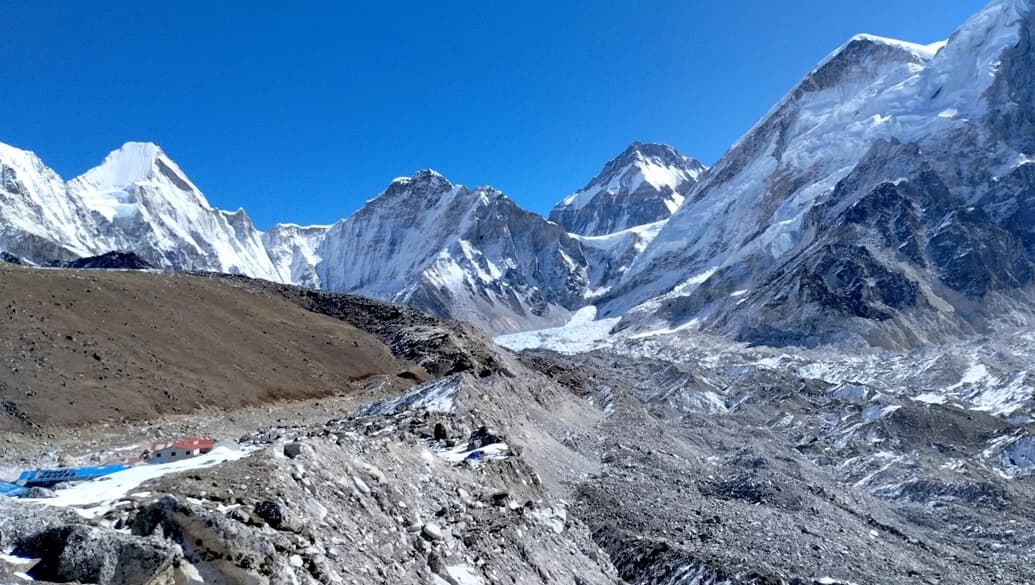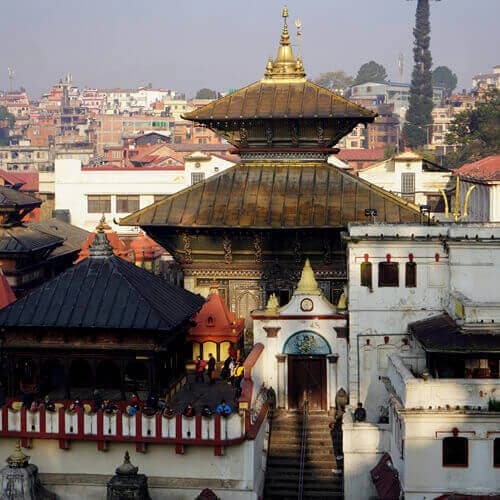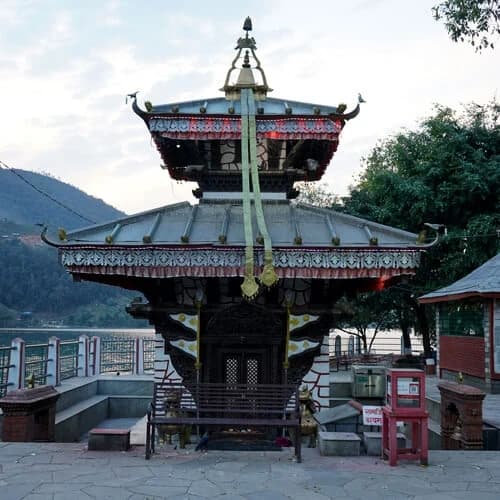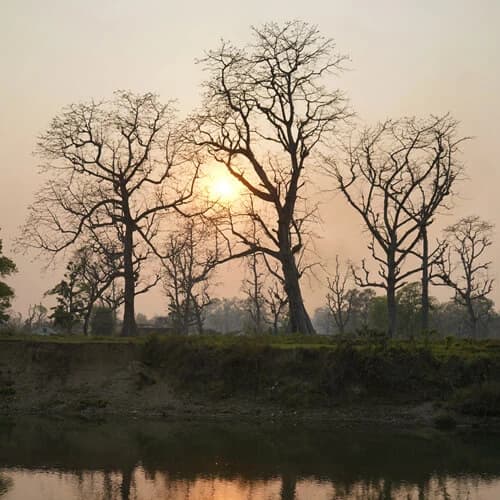Everest Three High Passes Trek with Island Peak Overview
The trail goes clockwise, starting from Lukla to Renjo La Pass, Gokyo Lake, EBC, and Island Peak. Along the way, you will rest at various stops to acclimatize appropriately to the changing atmosphere and increasing elevation. Thus, it makes it one of the perfect expeditions for travelers seeking adventure with proper safety measures included. It is also ideal for those who want to experience the Everest region's authentic cultural experience and spiritual immersion. In this tour, the trail will lead you to numerous Sherpa villages, where you can witness the lifestyle of the local community. You will walk past several monuments, prayer wheels, and Buddhist monasteries, allowing you to learn about their tradition and heritage as well. Moreover, the abundant vegetation of the region makes it a perfect habitat for several exotic species. You can even catch glimpses of elusive animals on the trail, including barking deer, blood pheasant, and blue sheep.
Each of these spectacular passes offers its unique challenges and rewards, including views of Mount Everest (8,848 m), Cho Oyu (8,188 m), Lhotse (8,516 m), and Makalu (8,485m). This package is ideal for ambitious adventurers who have submitted Himalayan peaks more than once. As you will be scaling high-altitude icy landscapes, it's best to have prior trekking and climbing experience. In this adventurous tour, you will be summiting the Island Peak (6,190m), also known as Imja Tse among the locals. It lies close to the famous Everest Base Camp (EBC) and is one of the highly climbed peaks in the Everest region. You can trek several trails to reach the peak, but one of the exciting routes to conquer its summit is crossing the three high passes.
Everest Three High Pass Trek with Island Peak Trip Highlights
- Hike one of the off-beaten trails in Nepal.
- Cross exhilarating high passes, including Kongma la (5,535m), Renjo La (5,360m), and Cho La (5,420m).
- Walk to the base camp of the world’s highest peak, Mount Everest.
- Immerse yourself in the spirituality within the land of magic and Shamanism.
- Explore Ngozumpa Glacier, and Gokyo Ri.
- Thrilling flight from Kathmandu to Lukla.
- Short hike to Hotel Everest View.
- Visit Thame Village, which is home to several famous monasteries.
- Witness astonishing views of Mount Everest, Lhotse, Cho Oyu, Nuptse, and Ama Dablam.
- Savor the tranquility and serenity of the pristine Gokyo Lakes.
What Makes Everest Three High Pass, Including Island Peak, Unique?
Everest Three Pass Trek including Island Peak, is a distinctive expedition that stands out for several reasons. This tour provides the thrill of crossing three of the highest passes and the opportunity to summit Island Peak. Throughout this remarkable journey, you will enjoy stunning panoramic views of Everest, Nuptse, Lhotse, and Ama Dablam. Moreover, you will experience the serenity of the Gokyo Lakes and explore other iconic locations along the way. This trip also immerses travelers in the local lifestyle and culture of the Sherpa people. Thus, we are offering you an incredible opportunity to participate in festivals, including the famous Mani Rimdu. The inclusion of the Island Peak climb also adds a mountaineering element to the tour. As a result, it offers a taste of climbing in the Himalayas without the need for advanced skills and equipment. Nonetheless, it's always best to have previous trekking experience to complete these treks without hassle. We also suggest you be at a good fitness level to tackle the challenging terrain. Overall, the Everest Three Pass including Island Peak, is a holistic, comprehensive adventure that combines nature, culture, and mountaineering.
The Journey Takes You to the Heart of the Everest Region
The remarkable adventure to the Island Peak begins with the thrilling and scenic flight from Kathmandu to Lukla. Upon your arrival at the picturesque village, you will have a short briefing with the trek members for the journey ahead. Eventually, you will trek to Namche Bazaar through several Sherpa settlements, including Phakdong and Monji. From Namche Bazaar, the trek routes follow the Bhote Koshi Valley and cross Renjo La Pass towards Gokyo Valley. Along the way, you will enjoy magnificent mountain vistas and go to the second pass named Cho La. This is also one of the vantage points from where you will have unobstructed panoramic views of the surrounding icy landscapes. Moving on, you will hike to Gorakshep and ascend to Everest Base Camp. After celebrating the moment and exploring the surrounding areas, you will descend to Lobuche. The route from here leads you to Chhukung via the Kongma La Pass. Upon your arrival at Chhukung, we will have a briefing and a short pre-climbing training. Our guides will also assist you with the techniques and proper ways to operate the climbing gears. After completing the brief training, you will begin climbing Island Peak the next day. The ascent to the summit is quite challenging, but with the assistance and expertise of our guides, you will be able to achieve it successfully. You will then retrace your steps back to the Chukkung village and make your way to Namche Bazaar in the coin days. We will have a farewell dinner at an authentic Nepali restaurant in Thamel to celebrate our achievements. During this occasion, we will have a wonderful time with our trek members and share our experiences and memories of the journey.
How Difficult Is the Everest Three High Pass Trek and Island Peak Climb?
The Island Peak in the Imja Khola Valley is one of the best-practice peaks for novice mountaineers. The difficulty of the expedition is graded to be moderate as the peak has been listed at the "2B" level in the Alpine Grading System. Even though it is among the practice peaks, travelers should still be aware of the challenges and should be well accustomed to mountaineering tools. Climbers must have a basic understanding of mountaineering techniques and the use of gears and equipment. These include crampons, ice axes, harnesses, snow bars, climbing ropes, and ice screws. Moreover, you will have to hike for almost three weeks in the icy terrains of the Everest region, which makes the expedition significantly challenging. The route will consist of areas affected by landslides, steep terrains, and rugged landscapes. Therefore, you must be an experienced trekker who has completed one or two high-altitude expeditions to successfully complete this exciting journey.
Is This Trek Suitable for You?
Everest Three High Passes Trek with Island Peak, is an exceptional journey but only suitable for some. The trek is best for travelers with high physical endurance and prior experience in high-altitude expeditions in the Himalayas. As this tour involves crossing three challenging passes, you will experience strenuous ascents and descents in extreme weather conditions. Similarly, you will be hiking at altitudes exceeding 5,000 m, so trekkers unfamiliar with such environments might experience physical exhaustion and altitude sickness. Thus, we can suggest other alternatives if you do not have previous trek experience or are physically weak. You can experience the wonders of the Everest region from our different packages, including the Everest Base Camp Trek and Gokyo Valley Lake Trek. On the other hand, if you are a seasoned trekker, this expedition is the right choice to experience an immersive and adventurous journey in the Everest region. However, we highly recommend understanding your physical limits and assessing yourself before the tour. It is always advisable to get yourself checked by a professional and indulge in training before the start of the trek.
How You Should Train Physically for Peak Climbing
The climb to the Island Peak is comparatively less difficult than other mountaineering expeditions in Nepal. Nonetheless, the trek takes place at an altitude of over 4,000 and requires considerable physical endurance and stamina. The best way to train physically for such a climb is by jogging and walking up stairs with 30-pound luggage on your back for more than an hour daily. At higher elevations, your heart and respiratory rates increase due to the less oxygen in the atmosphere. Therefore, we recommend you indulge in cardiovascular exercises to tackle such conditions. This includes workouts like swimming, running, and cycling, which will increase your stamina and develop core muscles. We also advise clients to include an aerobic fitness routine in their workout plans. Doing so will stimulate your body and make it flexible to avoid any injuries during the trek or the climbing session. Besides, to provide you with a general idea regarding the experiences needed, here are some basic familiarity you should have.
- Ability to carry 45 lb of backpack on hikes.
- Previous mountaineering experience.
- Winter camping experience.
- Rock or ice climbing experience.
- Medical training in emergencies.
Don’t Ignore the Risk of Altitude Sickness
Because of the extreme elevation gain, altitude sickness is a significant concern on the Everest Three High Pass including the Island Peak Trek. The signs of the illness can occur when a traveler ascends above 2,500 m, and the risk significantly increases above 5,000 m. Some common symptoms of altitude sickness include dizziness, headaches, fatigue, nausea, and difficulty sleeping. In severe cases, it might develop into serious conditions such as High Altitude Cerebral Edema (HACE) and High Altitude Pulmonary Edema (HAPE). Therefore, one must pay attention to the early signs and acclimatize adequately on the trek to adapt one's body to the decreased oxygen levels in the air.
What Should I Do if I Get Altitude Sickness?
If you experience signs of suffering from AMS, you must notify your trek leader or guide immediately. Here are some quick responses you must follow to ensure your well-being on the trek.
- Walk slowly and steadily, and do not rush on the trail.
- Hike down to a stop at a lower altitude and get some rest until you feel better.
- Hydrate yourself and avoid highly caffeinated beverages.
- Drink natural remedies such as lemon, ginger, and garlic soup.
- Intake Diamox and get 7-8 hours of sleep every night.
- Consume food that is high in carbohydrates to energize your body.
- If the symptoms persist, you will be evacuated by a helicopter for immediate medical attention.




